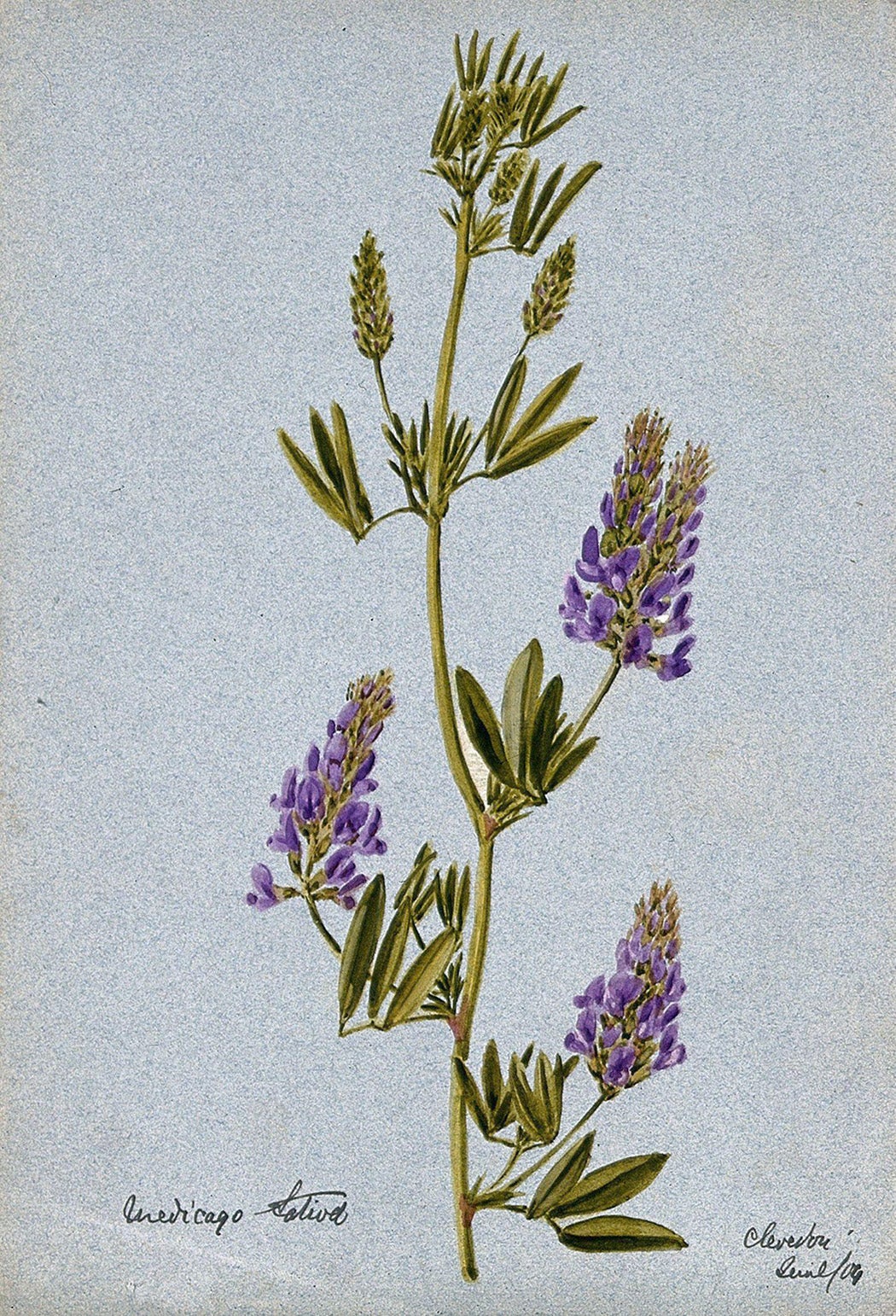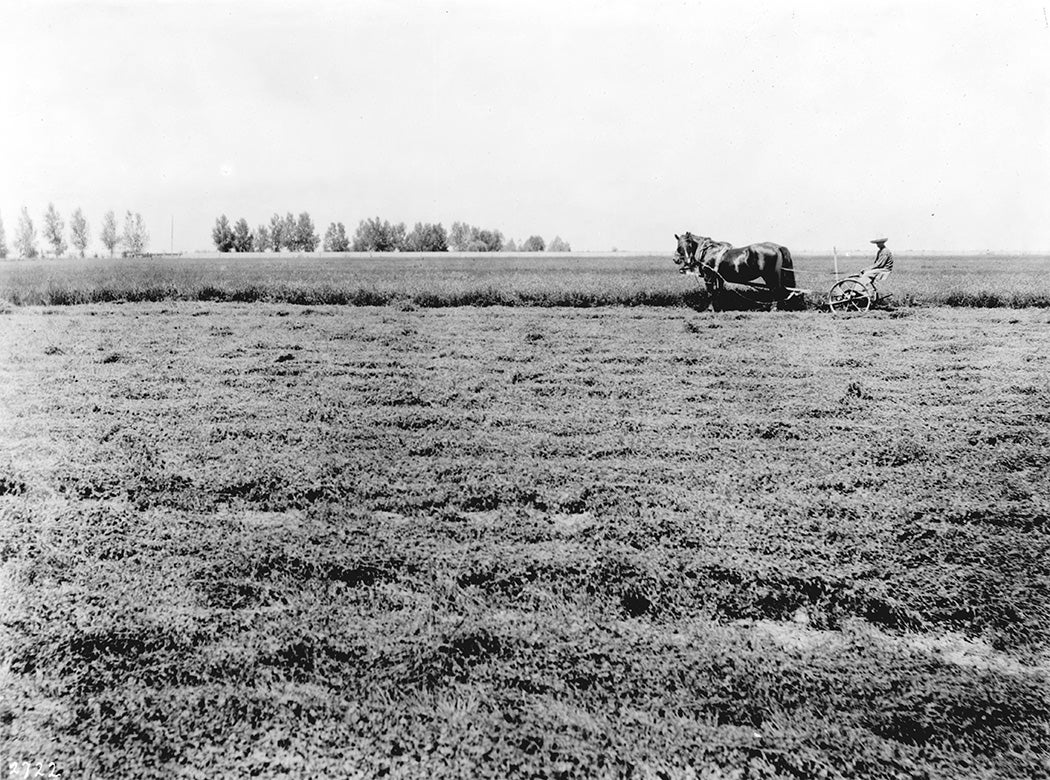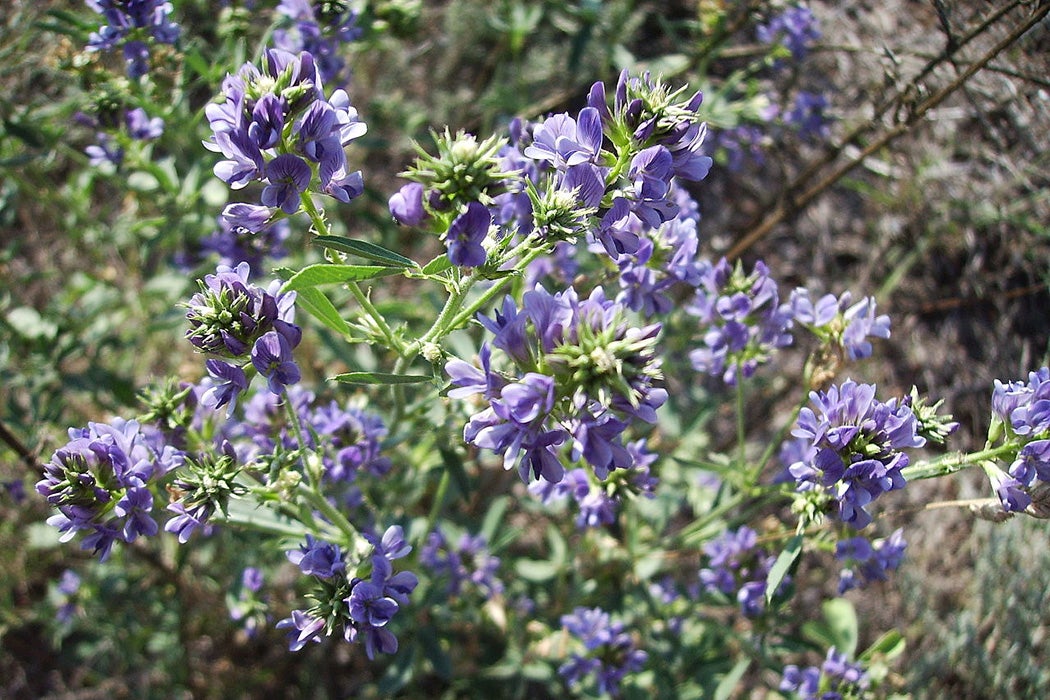In the American West, a fight has emerged over who gets the water: people or alfalfa? During the 2023 megadrought, lawmakers in Washington, DC, called for individuals to conserve their water usage. According to reporting by Vox, humans use a meager 13 percent of Colorado River basin water for activities such as showering and watering lawns. In contrast, around 79 percent of water drawn from the Colorado River is used for irrigating crops. The majority of that 79 percent is used to water crops like alfalfa, a legume hay, which ultimately feeds livestock.
Alfalfa, one of the most important foods for cattle, is the third most valuable crop in the United States, but it’s often overshadowed by other commodity crops such as corn and soybeans. While most alfalfa is grown in the Midwest, the top yielding states per acre are in the West, in states like Arizona, California, Washington, and New Mexico, where its growth depends on irrigation. In a 2022 Gastropod episode on alfalfa and the Western megadrought, hosts Cynthia Graber and Nicola Twilley interviewed California farmer Jack Seiler, who told them that he could “harvest at least eight times and get approximately 10 tons per acre per year.”
In 1753, Carl Linnaeus classified the plant as Medicago sativa, which comes from “medick,” the Greek word for alfalfa, and sativa, which indicates the plant is cultivated. The word “alfalfa” may have come from the Arabic al-fasfasa, which means horsepower, or the Persian aspo-asti, which means horse fodder, according to Michael P. Russelle. Both these words refer to one of the most prized qualities of alfalfa: its use as an animal feed.

According to Russelle, “charred seeds of wild alfalfas have been identified in [strata] layers that date to about 6000 [BCE] at Ali Kosh, in present-day southwestern Iran.” In present-day Syria, there have been found charred alfalfa seed remains from 10,000 BCE. The first known written record of alfalfa isn’t quite as old. We find it in the tablets of the ancient kingdom of the Hittites (c. 1400–1200 BCE), which describe the feeding of animals with alfalfa hay. In a 1949 Economic Botany article, Francis P. Griffiths recounts Pliny the Elder’s assertion that “alfalfa was introduced into Greece upon the invasion of that country by Macedonians and Persians,” likely around 490 BCE.
Russelle writes that alfalfa spread to China via the Silk Road in the second century BCE, when a Chinese general returned home with horses and “the renowned horse fodder alfalfa.” The grass was likely distributed throughout the Roman Empire in the first and second century CE. Some scholars, like F. D. Coburn, speculate that the Moors brought the plant to Spain around 700 CE, an assumption in part due to the above-noted similarity of “alfalfa” to the word for the plant in Arabic. It wasn’t until the Renaissance that talk of alfalfa exploded, notes Russelle, and “many references to alfalfa were made in the profusion of 16th-century texts about farming throughout northern and central Europe.” In much of Europe, the word for alfalfa is “lucerne,” potentially derived from the Persian word for the blue mineral lazurite, which may refer to alfalfa’s blue-purple flowers.
Alfalfa was brought to the New World in the sixteenth century by way of Portuguese and Spanish explorers. In 1906, ignoring the Indigenous people of the Americas, Coburn writes that “Spain…was to perform at least two important services for half the world, if none for herself. She was to reveal to civilization a new continent, and give to it the most valuable forage plant ever known [, alfalfa].” In the eighteenth century, an increase in beef production meant an increased need for pastureland. According to Russelle, in Argentina, “alfalfa rapidly became a crucial component of improved pastures in Argentina, expanding in area from about 250,000 acres in 1872 to about 3.7 million acres by 1900 and to 18 million acres today.”

By the eighteenth century, alfalfa had also become a staple on Southern plantations in the United States. Even George Washington was ordering seeds for Mount Vernon, writes Russelle. By the late 1800s, the fodder grass became increasingly recognized as a crop that could feed the US’s growing demand for dairy and beef. As one author in the Arizona Republican explained in 1895, “Alfalfa alone, green or in the stack, makes cattle butter fat and of a superior quality, flavor and color. It is bound to be a big industry this cattle feeding.” In 1949, Griffiths estimated that “the industrial utilization of alfalfa is today in an infant stage which compares with the development of the corn and soybean industries 30 years ago.” By the late 1900s, alfalfa would be all grown up.
Alfalfa production in the US peaked in the mid-1980s and has been declining ever since, likely due to “the decline in the price of hay relative to the price of corn,” explains agricultural economist Carl Zulauf. Still, in 2023, American farmers grew more than 9 million acres of alfalfa.
Weekly Newsletter
As global demand for meat increases, food for cattle, such as corn, soybeans, and alfalfa, will only see an increase in demand, too. As the dairy and beef industries become more industrialized, producers are craving high-quality alfalfa, which can strengthen “milk production and economics of a dairy operation.”
However, alfalfa’s sustainability remains uncertain as concerns over drought conditions continue. Some scientists are already working to develop climate-resilient alfalfa varieties that can withstand extended arid conditions and other extreme weather events. And though alfalfa is a water-demanding crop, it has benefits to the environment, as well. It can act “as a great sponge for excess nitrate and water,” Russelle writes. Even so, there’s one cash crop at the center of water shortages in the American Southwest, and that’s alfalfa. The Plant Humanities Initiative at Dumbarton Oaks seeks to explore the ways humans, plants, and societies are interconnected.
Editor’s note: This article has been amended to clarify that alfalfa is not a grass hay. It’s a forage legume.
Support JSTOR Daily! Join our membership program on Patreon today.








